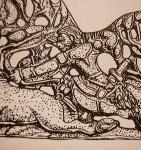Hi, Michael
I believe we're thinking along the same lines. Here's something to add to your above post. First of all Herodotus used information taken from Aristeus, the Greek poet who traveled the trade road to the Altai. So, quite conceivably, Aristeus interpreted the name "Arimaspi" as "One-Eyed Men." Obviously, through speakers of Northeastern Iranian, the tribe was actually described to him as "The Horse-Lovers" or "Horse-Breeders." This term fits the well-bred Akhal-teke horses found in Pazyryk and Ukok kurgans. There is also a direct geographical link between the Altai cultures and the Yuezhi described in Chinese sources.
The oldest reference comes from the Mu Tianzi Zhuan, written just prior to 500 BC. At that time, the Yuezhi lived north of Hetao and northwestward to the Altai. Hetao is located at the "Bend" of the Yellow River, the land north of it being the Ordos, the areas east occupied by a forming Xiongnu state. The Yuezhi were supplying the Chinese with horses, carnelian, and a jade-like stone, in trade for silks and the occasional bride (who, of course, arrived in a fancy carriage). How inextricably odd this record falls exactly at the height of the Pazyryk culture.
If we add this info to later locations and interactions, we have horse-breeding tribes (the Yuezhi and Wusun) trading with the Han Chinese, the two tribes also mired in a love-hate relationship with the Xiongnu, sometimes a dependent, then breaking away, etc. Your suggestion that warriors depicted on the Ordos buckles are Yuezhi actually fits perfectly; and these same mustached individuals are again shown in Kushan frescoes and on the Orlat battle plaque; the only difference, it would seem, is a slightly shorter hair style. Check this out:

Another piece of Ordos art, this one showing a Yuezhi-kinda-guy drawing back on an asymmetrical bow and wearing a long sword hanging from a scabbard slide. So those authors who speculated the scabbard slide was introduced to the Chinese by the Yuezhi certainly have a leg to stand on. And of course, we are also viewing a precursor to the Orlat plaque.
For an excellent PDF resource, read Sino-Platonic Paper No. 80 (July, 1998), A Study of Saka History, by Taishan Yu. Not only does Yu consider the Yuezhi as Saka, but he also discusses other Saka tribes, such as the Kanju, Yancai, and Wusun. Professor Yu uses ancient Chinese texts not found in the Shiji, many of them written in the pre-Qin era.
Ain't it odd how it all comes together.
I believe we're thinking along the same lines. Here's something to add to your above post. First of all Herodotus used information taken from Aristeus, the Greek poet who traveled the trade road to the Altai. So, quite conceivably, Aristeus interpreted the name "Arimaspi" as "One-Eyed Men." Obviously, through speakers of Northeastern Iranian, the tribe was actually described to him as "The Horse-Lovers" or "Horse-Breeders." This term fits the well-bred Akhal-teke horses found in Pazyryk and Ukok kurgans. There is also a direct geographical link between the Altai cultures and the Yuezhi described in Chinese sources.
The oldest reference comes from the Mu Tianzi Zhuan, written just prior to 500 BC. At that time, the Yuezhi lived north of Hetao and northwestward to the Altai. Hetao is located at the "Bend" of the Yellow River, the land north of it being the Ordos, the areas east occupied by a forming Xiongnu state. The Yuezhi were supplying the Chinese with horses, carnelian, and a jade-like stone, in trade for silks and the occasional bride (who, of course, arrived in a fancy carriage). How inextricably odd this record falls exactly at the height of the Pazyryk culture.
If we add this info to later locations and interactions, we have horse-breeding tribes (the Yuezhi and Wusun) trading with the Han Chinese, the two tribes also mired in a love-hate relationship with the Xiongnu, sometimes a dependent, then breaking away, etc. Your suggestion that warriors depicted on the Ordos buckles are Yuezhi actually fits perfectly; and these same mustached individuals are again shown in Kushan frescoes and on the Orlat battle plaque; the only difference, it would seem, is a slightly shorter hair style. Check this out:
Another piece of Ordos art, this one showing a Yuezhi-kinda-guy drawing back on an asymmetrical bow and wearing a long sword hanging from a scabbard slide. So those authors who speculated the scabbard slide was introduced to the Chinese by the Yuezhi certainly have a leg to stand on. And of course, we are also viewing a precursor to the Orlat plaque.
For an excellent PDF resource, read Sino-Platonic Paper No. 80 (July, 1998), A Study of Saka History, by Taishan Yu. Not only does Yu consider the Yuezhi as Saka, but he also discusses other Saka tribes, such as the Kanju, Yancai, and Wusun. Professor Yu uses ancient Chinese texts not found in the Shiji, many of them written in the pre-Qin era.
Ain't it odd how it all comes together.

Alan J. Campbell
member of Legio III Cyrenaica and the Uncouth Barbarians
Author of:
The Demon's Door Bolt (2011)
Forging the Blade (2012)
"It's good to be king. Even when you're dead!"
Old Yuezhi/Pazyrk proverb
member of Legio III Cyrenaica and the Uncouth Barbarians
Author of:
The Demon's Door Bolt (2011)
Forging the Blade (2012)
"It's good to be king. Even when you're dead!"
Old Yuezhi/Pazyrk proverb






